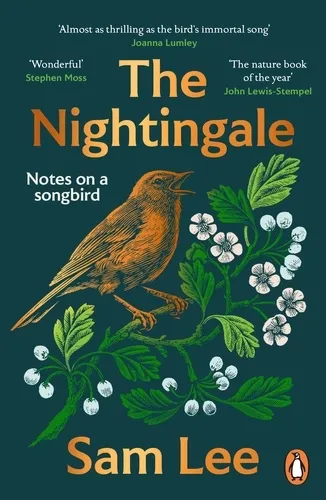
Many will know Sam Lee as an award-winning singer, a folk music specialist dedicated to collecting and interpreting Britain’s oral tradition. Some will know him for his work as musical director for RSPB’s ‘Let Nature Sing’, while others will know him through his springtime concert series ‘Singing with Nightingales’, where an audience is led out into darkness of a late spring evening to hear Nightingales and human performers create music in each other’s company, and sometimes together. All three of these ‘Sam’s’ coalesce around an incredible passion and enthusiasm for the (not so) Common Nightingale, something that is evident throughout the book.
There is a wonderful richness to this book, both in terms of what it contains and how it is written. The manner in which the book has been set out places it somewhere between a species monograph (though virtually reference free) and nature writing. It is not a straight narrative, in that it contains artwork, illustration and break out sections that occasionally disrupt the flow but more often add to the richness. It has thicker, brighter paper than you would usually see, beautiful endpapers and a stitched in ribbon to mark your page, but no index, and is a wonderful size in the hand when reading.
The first few chapters introduce the Nightingale, bringing much of our current (and former) knowledge of the species together in a was that is both easily accessible and engaging to read. Sam Lee weaves personal encounters into the text, drawing you in, posing questions and presenting ideas in an almost conversational manner. In addition to learning about the bird – its behaviour, habitats, migrations and population decline – we also learn about human responses to its song, which goes on to be the main focus of the book.
The bulk of the book is dedicated to the cultural impact of the Nightingale, exploring the bird’s role in literature, music, folklore and tradition, not just here in the UK but across cultures and through time. As you might expect, there is reference to John Keats (Ode to a Nightingale), to Beatrice Harrison (the cellist who famously played with these birds in her Oxted garden), to John Clare (The Nightingale’s Nest) and to Greek mythology (Procne and Philomela). However, not only are these particular cultural references explored in more and better detail than usually seen – did you know about D H Lawrence’s witty response to John Keats poem? I didn’t! – but they also form just a small part of a very much wider trove of stories, folklore and song presented with similar authority. Nowhere else is the richness of Nightingale lore presented so eloquently or so completely as it is here.
Folk song features strongly, as you might expect from an author who has spent more than a decade learning the old songs from the now diminishing number of families who have kept them alive from one generation to the next. As Sam Lee notes, when it comes to folk song, "the Nightingale tends to reveal more about the culture that is singing about him or her than about the actual nature of the bird." And so we learn not just about the bird, but also about the oral tradition and the singers and communities who have woven the Nightingale into their own stories. One of these communities is the one of which Sam is himself a member, those aware of the tremendous impacts of our activities on this once more common bird and who have used the species as a rallying call to face our environmental crisis head-on. The book ends with a very personal call to action, recognising the need for us all to engage with nature and asking the reader to be present and pause, so that we can "give renewed adoration towards that small, quiet beauty, so hidden from our daily worlds…" This wonderful book not only gives practical advice on how to do this, but it also helps us better understand our connections with the rest of the natural world, and in particular with this very special bird.
Reviewed by
- Author: Sam Lee
- Publisher: Century, London
- Publication year: 2021
- ISBN: 9781529124835
- Format: Hardback
- Page count: 248
- RRP: £14.99
- Available from: NHBS
